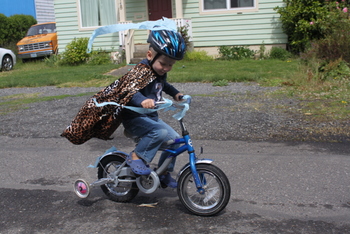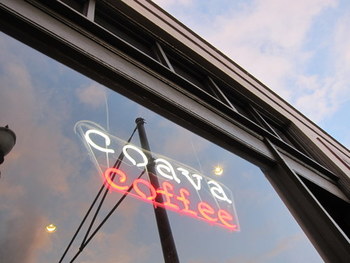If someone created a list of signs that Portland is starting to grow on you, one of them would have to be, “You spend more time on your bike than in your car.” That describes me, at least when the weather is good (true Portlandians commute by bike in the rain, but I’m not there yet). Portland prides itself as a bike-friendly city, with lots of trails and designated biking streets (complete with sharrows!) that fill up with bicycles during the morning and afternoon commutes.
Traveling around Portland by bike is invigorating. Similar to walking, when you’re on a bike, you get to experience the sights, sounds, and smells of the city at a much more intimate level than you would if you were in a car (a good thing, until you get stuck behind a garbage truck). Riding in traffic provides an adrenaline rush because you are moving pretty fast without much to protect you. Lurking in the back of your mind, especially when you’re riding fast, is that you could crash at any time, and hitting the pavement hurts. Believe me.
Since I started biking in Portland two years ago, I’ve wrecked twice. The first time, I was hit by a car (yeah, that was fun). Riding up Naito toward the Hawthorne Bridge in the bike lane, a driver forgot to check her blind spot before pulling into a parking space, and unbeknownst to her, she had to go through me to get there. Fortunately, the crash was more of a sideswipe than a full-on collision. Plowing through her right side mirror, I bounced up onto the curb and landed on my side. We were both lucky, as I came away with nothing more than a few scratches on my foot, and she came away with no insurance claims from me. She seemed more traumatized by the collision than I was.
The second time I crashed, it was my own damn fault. I was getting ready to move into the left-hand turn lane, and as I looked back to check my blind spot, I hit either a pothole, or a buckle in the pavement. The bump jolted me just enough that I lost control of the front wheel, and once the wheel gets crosswise, it’s over. I crashed hard and slid several yards across the asphalt. Without a helmet, I would probably have ended up in the hospital—I remember my head plummeting toward the pavement, thinking, “Uh-oh, that’s going to hurt,’ then after it bounced off, “Oh wait, it didn’t.” The rest of me wasn’t so lucky, though. I came away with a nasty case of road rash on my right side, from my shoulder to my foot (wearing shorts and sandals didn’t help). Several months later, I can still see the scars.
Crashes notwithstanding, I still ride my bike everywhere, and recently, I learned something about biking that is applicable to coffee (it’s kind of a stretch, but bear with me). My bike’s brakes were getting worn, and my ability to stop had become pretty sketchy. Once I fixed them and could stop more quickly, I felt much more comfortable traveling at higher speeds, much more in control of the bike. In other words, improving my ability to slow down actually helped me speed up (now, if only I can get my legs in better shape).
Limits can be Good
It seems counterintuitive that being able to stop, or hold myself back, would actually help me go faster, but that’s what happened. In the case of coffee, having limits can improve quality and creativity. When I was doing interviews for my book, I had a long conversation with Devin Chapman, the 2012 and 2013 Northwest Regional Barista Champion. Chapman, who was working as the retail manager at Coava at the time (he left the company at the end of September), brought up the idea of culinary liberties, and how it applied to the café setting.
Chapman defined culinary liberties as the concept that a restaurant’s chef has the authority to develop a menu, with the understanding it cannot be changed. In other words, the chef puts limits on what is available, and off-menu ordering is not allowed. While this seems presumptuous to some people, it allows chefs to have their creations presented exactly as they want them. Chapman said that patrons in Portland are accustomed to this practice, at least the city’s nicer restaurants.
The idea is not as widespread in the coffee industry. Starbucks helped create what, for the purposes of this post, I’ll call the unlimited choice café model. The company likes to brag about the 80,000+ different beverage combinations (including modifications) that are on the menu. Starbucks regularly has 10-15 syrups available, depending on the season, and customers can ask for as much or as little of each in their drinks as they want, along with all kinds of other tweaks and special orders. They truly can have their coffee their own way, and the company has been hugely successful with this strategy.
In a movement away from the Starbucks model, often called the third wave of coffee, the better cafés in Portland (and around the country) have gone against this trend, limiting the number of syrups they offer, with the intention of raising customers’ appreciation for coffee. They take the stance that if the coffee is good enough, other additions are unnecessary. For business purposes, most cafés still offer a few syrups—vanilla, chocolate, and maybe a couple others—but they often store them ought of sight, to encourage customers to try the coffee without them. Photo courtesy Jinsu Lee.
Photo courtesy Jinsu Lee.
Coava, on Southeast Grand Avenue, takes an even stronger stand for selling straight-up coffee than most companies, offering one of the most limited café menus in Portland. Every day, Coava has two types of brewed coffees available as pourovers and two types of espressos available, but unlike almost every other café in the city, Coava does not have any syrups available. None. No vanilla. No chocolate. No whipped cream, and the largest drink on the menu is 10 ounces. The anti-Starbucks, so to speak.
In a culture that likes to believe that having unlimited choices is a symbol of freedom, why would Coava choose to not offer everything they possibly could to make customers happy? There are several reasons. First, the practice completely aligns with the ethos and culture of the company, which is to showcase coffees and the farmers who grow those coffees. Second, it makes Coava unique among its peers. Third, and maybe just as important, having fewer options fits with the company’s dedication to craftsmanship. If you follow Coava’s Twitter feed, the company regularly tweets about developing skills by performing actions repeatedly. Being a barista, or a coffee roaster, takes practice, and if you practice regularly with the idea of improving, eventually you will get better. Having a limited menu helps baristas hone their skills more finely, because they make the same drinks more frequently. You might not be able to get everything at Coava, but you can be sure that what you get will be good quality. Judging by the lines that I see every time I go into the café, the concept is working well.
Which reminds me, another sign for the aforementioned list could be, “You spend more on coffee in a month than you do on gas.” Hmmm....